… still more Wind Turbine Syndrome (Ontario)
….
….
—Calvin Luther Martin, PhD
·

Late last month we drew your attention to a Special Issue of the Bulletin of Science, Technology, and Society, devoted to Wind Energy and Health. (Yes, this is a peer-reviewed journal.) The articles are important; it’s worth underscoring this once again. (Unfortunately, you have to buy them from the Bulletin, and they ain’t cheap.)

Dr. Helen Parker (Lic. Clinical Psychologist, Martha’s Vineyard, MA) has kindly put together a PDF of all the article abstracts. Reading merely the abstracts, it becomes clear that Big Wind’s knee-jerk denial of health impacts is a public health outrage and an insult to intelligence—a point Pierpont and others have made for years. Big Wind’s across-the-board culture of denial has reached the point of outright buffoonery. (One thinks of the Libyan bully, Muammar Gaddafi, a past master of similar buffoonery—now finally toppled by an outraged and insulted citizenry.)

Gaddafi: Outrageous, insulting bully. Patron Saint of Wind Energy (nominated by WTS.com)
Fast forward to reality. We especially urge you to read Dr. Carl Phillips’s magisterial analysis of the existing research on Wind Turbine Syndrome.
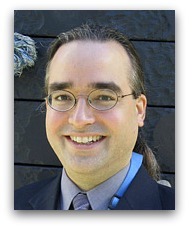
Phillips is a Harvard-trained PhD specializing in public policy and epidemiology. He has held a major post-doctoral fellowship in this field and has been faculty in schools of public health at several prominent universities.
·
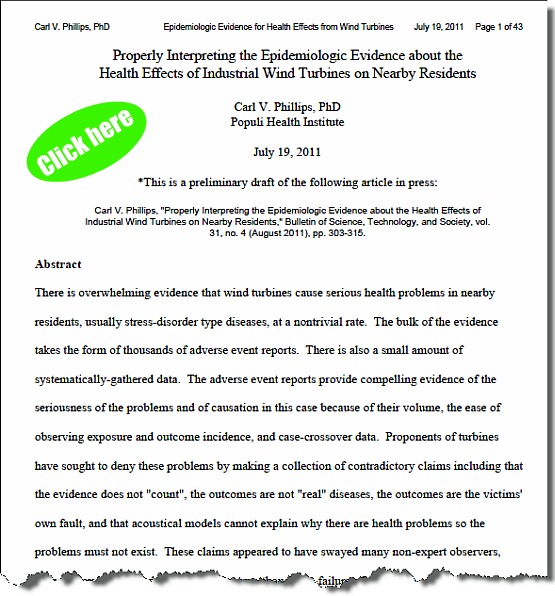
 Wind Developer Creed: “It’s my way, or the highway!”
Wind Developer Creed: “It’s my way, or the highway!”·
—Alex Sinnott, The Warrnambool Standard (8/25/11)
Major wind farm projects at Hawkesdale and Yambuk have been thrown into limbo after the Moyne Shire advised the state government to block a permit extension to developers.
Planning Minister Matthew Guy yesterday indicated he would accept the council’s advice, effectively killing off $430 million worth of proposed investment in renewable energy infrastructure.
Moyne Shire councillors voted on Tuesday night to oppose extending permits for the proposed Hawkesdale and Ryan Corner wind farm projects, granted to developers Union Fenosa three years ago.
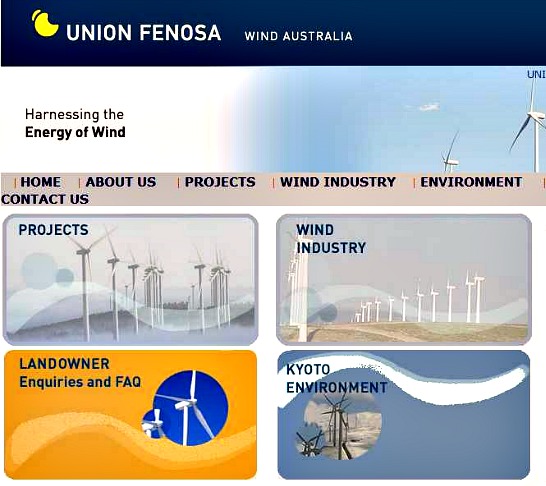 … from Union Fenosa website
… from Union Fenosa websiteThe Standard understands the move is the first time that a Victorian council have been able to successfully oppose a wind farm proposal since the Baillieu government won office last year.
Mr Guy vowed earlier this year to return planning power on major energy projects to local government, in contrast to predecessor Justin Madden’s centralised approach to decision-making.
Moyne mayor Jim Doukas said many renewable energy developers had become arrogant and believed the council decision was a warning to other project operators. He said councillors were unimpressed with how Union Fenosa consulted council and the wider community.
“Renewable energy developers think they have carte blanche with local shires, that we’ll just rubber stamp whatever they want,” Cr Doukas said.
“Well, those days are over. It has been overkill for the past couple of years and this Ryan Corner knock-back is a big wake-up call to the others (energy developers) that they need to lift their game.”
Cr Doukas said Union Fenosa had failed to update its wind farm blueprints for the Ryan’s Corner and Hawkesdale projects, omitting important details such as changes to state government set-back rules.
He said the developers had been “a little arrogant in assuming that Moyne Shire would rubber stamp the project.”
A spokeswoman for the Planning Minister said the state government was committed to returning energy project decision-making to local councils.
“The Coalition government committed to giving planning authority back to local councils on wind farms,” she said.
“We have done that and Moyne’s decision shows that this is now the case.”
Changes to noise standards, turbine “set-back” requirements and aesthetic reasons were cited by Moyne councillors as reasons to oppose the present permit lodged by Union Fernosa.
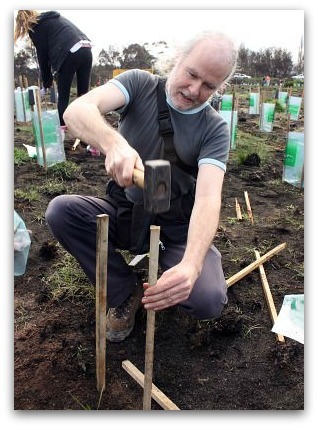 Cam Walker
Cam WalkerFriends of the Earth spokesman Cam Walker said the decision would set a disturbing precedent.
Mr Walker said it would push wind turbine development interstate.
He said yesterday’s application knock-back was the first time a local council had opposed a renewable energy development under the state government’s new planning rules.
Former planning minister Justin Madden announced in August 2008 that the state government would give the go-ahead to the 68-turbine Ryan Corner development and a smaller 31-turbine project at Hawkesdale.
A Union Fenosa spokesman said wet weather during the past season had prevented developers from accessing the Ryan Corner site sandwiched between Orford, Yambuk and Port Fairy.
Similar wet conditions were reported at the Hawkesdale wind farm site, south-east of the township.
However, a company representative was unable to comment to The Standard last night on the Planning Minister’s decision.
 With appreciation to James Wiens
With appreciation to James Wiens
·
—Barbara Draper, Rock River Times (8/24/11)
I live 1 mile from the city limits of Ohio, Ill., in Bureau County on the Big Sky Wind farm, which covers approximately 13 square miles, more or less. In that area, there are at least 56 turbines, and 30 are on land owned by absentee landowners who do not have the negative effects of shadow flicker, poor TV reception or noise.
In that same 13-square-mile area, there are 47 homes, excluding those in the Village of Ohio. Ten of those homes belong to and are lived in by people who have turbines on their farm. The other 37 homes are owned and occupied by residents who are not participating in the wind farm.
We are among those 36 nonparticipating homes because we chose not to have a turbine on our farm, as did two other farmers in our area. However, most of those 36 homes are on small rural estates, and they had no choice for a turbine.
We have 12 turbines located around our house that vary in distance from less than a quarter-of-a-mile to three located less than a mile. There is no window in our home to look out without seeing turbine blades going round and round. I have taken pictures from my windows, if anyone is interested in looking at them.
As we sit on our patio, we are looking at 31 turbines spinning. The sound is a monotonous sound of whish, whish that can vary in intensity and, at times, has sounded like a train rumbling down a track. I refer to it as irritating, like a dripping faucet. It just never stops, unless the turbine is not running.
The beautiful countryside in our area has disappeared, along with the quiet and peaceful county living we once had.
We have shadow flicker many months of the year, from 15 minutes to more than an hour a day, whenever the sun is shining and turbines are running.
At a meeting before Big Sky was built, I asked about shadow flicker. The developer said I would have flicker for maybe two to three seconds a year. I should have had him write his statement down and sign it. My suggestion is that if a developer tells you something, have him sign a written statement to that effect.
Some mornings, we don’t need an alarm, because the flicker wakes us up. This fall, we will again have the most intense flicker starting in October and until the end of February. This comes from a turbine 1,620 feet (according to Big Sky measurements) southwest of our house.
The flicker is in every room in our house — we can’t get away from it. When we first experienced this, we thought something was wrong with our lights, but as our eyes kept moving to find the source — we just couldn’t figure it out. I then walked into the kitchen, and it was coming through the closed venetian blind — then we knew. That flicker lasted an hour. It made my husband feel ill, like motion sickness. The brighter the sun, the more intense the flicker.
This flicker is hard to explain to people. Flickering fluorescent lights in every room might be similar; however, they would not cast moving light on the walls and furniture.
This flicker comes through trees, blinds or lined drapes. Light-blocking shades would have to be sealed to the sides of the window.
The shadows are on our buildings, our lawn and across our field. Last fall, I covered the tops of my south windows with wide aluminum foil. I did this so I could look outside a few windows without seeing rotating blades. It didn’t keep out the flicker. I have now replaced the foil with pleated shades.
The Bureau County Zoning Board was told by a wind farm representative that 20 to 30 hours of shadow flicker a year was acceptable. It is not acceptable. I asked the representative if he lived on a wind farm. He answered, “No.”
Residents, especially nonparticipating residents, should not have any flicker in their house or any shadow from turbines on their lawn, outbuildings or farm land. I have read that this is a trespass.
An executive of Big Sky told us on the phone that we had a serious shadow flicker problem. The next time we talked with her, she denied saying it — another reason to get their statements in writing and signed.
A person has to live on a wind farm 24 hours a day, seven days a week, to really know what it is like. You cannot get the whole effect by just driving through it and stopping by a turbine for a short time. The conditions vary, hour by hour, day by day, and even season to season.
When Big Sky first started erecting the turbines, my husband and daughter drove to one — they couldn’t hear a thing. We thought, “Oh, this won’t be so bad.” One trip does not tell the story.
I realize wind farms are big money for participating farmers and tax-supported institutions. However, more consideration needs to be given in the placement of the turbines to eliminate what we are having in Big Sky.
We don’t live in the quiet rural county anymore. It has been replaced with an industrial wind park. They call it a wind farm — wrong — it produces no food. It just eliminates many food-producing acres.
These counties need to realize the impact of turbines and make their ordinances to protect the people. Shadow flicker should not have to be tolerated by rural residents. It is disturbing and has health consequences. I have been told that someone with seizures could not live in our home because of that intense flicker we have in the fall.
I also strongly believe no shadows from turbines should be cast across highways, as they are in Big Sky. Several drivers have told me they have been startled by them — slammed on their brakes, and some nearly ran off the road. I called the Illinois Department of Transportation, but was told they could do nothing as long as the turbine was not in their right of way — it was a county issue.
All of these problems are disturbing and serious problems, and there are health problems involved. I sometimes think this country has its priorities mixed up. I love nature and animals, but when a conservation area was given a farther setback from turbines in Lee County than we were given from our homes in Bureau County, I got disturbed.
I believe there needs to be much more study done on wind turbines before filling this nation’s countryside with them. In making your ordinances, please make sure your residents are protected from the negative effects of turbines.
·
—Randall J. Bell, President, Victorian Landscape Guardians Inc (Australia)
You could be forgiven for wondering why the wind industry and its cheer squad, the Australian Clean Energy Council (which is NOT a Government agency), is going ballistic lashing out at opponents of wind farms.
The reason is simple: the public is waking up to some inconvenient truths about wind.
What happens when there is no wind? There is no electricity. What happens when the wind is too strong and the turbines have to be braked? There is no electricity. What happens when the wind fluctuates wildly and the wind farm is “kicked” off the grid because of surging? There is no electricity, unless it comes from coal or gas fired generators (perhaps a little bit of hydro) which have to be in “hot spinning reserve” constantly shadowing these events. And this is at the cost of consumers at least three times the cost of coal-fired and twice the cost of gas-fired electricity.
But the news gets worse for the industry—which suffered a 7% fall in sales in Europe last year and the continued withdrawal of subsidies—with the release of a new study on 19 July 2011 by USA, Colorado-based energy analytics firm Bentek Energy, discussed in Forbes Magazine 7/19/11.
 … from the Bentek website
… from the Bentek websiteThe Bentek study carries considerable authority because it dealt with real data not computer models and “covered about 110 million customers, or about one-third of the U.S population in four regions.”
Because of space I will quote selectively from the article:
… the American Wind Energy Association (AWEA) and other wind boosters have vastly overstated wind’s ability to cut sulfur dioxide, nitrous oxide, and carbon dioxide.” In California “using wind energy doesn’t reduce sulfur dioxide emissions at all.”
“But the most important conclusion from the study is that wind energy is not “a cost effective solution for reducing carbon dioxide…”
“Wind’s energy carbon dioxide-cuttings benefits are vastly overstated”
“…The study undercuts the sector’s reason for existing.”
But here is the killer quote. “The wind energy business is the electric sector’s equivalent of the corn ethanol scam: it’s an over-subsidized industry that depends wholly on taxpayer dollars to remain solvent while providing an inferior product to consumers that does little, if anything, to reduce our need for hydrocarbons or cut carbon dioxide emissions.”
·
 Denise Bode, CEO, American Wind Energy Assoc., testifying before Congress
Denise Bode, CEO, American Wind Energy Assoc., testifying before CongressEditor’s note: The following is an announcement from the Australian Waubra Foundation. WTS.com considers it worthy of international circulation.
·
·
Existing Wind Energy Projects (WEP) do cause serious health problems for people living nearby. This is a fact, despite the denial, dissembling and spin by the industry and a few of their supporters; and continuing and diverse personal attacks on us as the whistleblowers.
Some of the tactics of the WEP proponents and supporters are:
• to ignore on the ground evidence, as “anecdotal,” whilst making no such inquiries themselves
• to declare there are no peer-reviewed studies (Including redefining that term in an attempt to dismiss some very good overseas work)
• to commission studies from their much favoured consultants; and of course
• mount personal attacks which merely demonstrate an unwillingness to engage the issues
The Waubra Foundation is the only Australian institution actually doing work in the field, accumulating objective data (as opposed to anecdotal), researching studies and technical papers from overseas (which are becoming very significant), and climbing step by step the monumental peaks of indifference and hostility to the fact that WEPs are a danger to health. We also persist in trying to have government and industry money allocated to independent research about the emanation of noise, the type of noise, the physical mechanisms of the health problems and safe setbacks of WEPs from homes and workplaces.
A problem is that independent research and peer review will take time, two to three years at a minimum; so people will continue to suffer from existing and new WEPs for several years. This continuing damage is unacceptable, an indication of a political system that accepts and promotes damage to rural Australians, a greedy and deceptive industry, and a cruel impost on part of what we thought was an equal society.
The Foundation has therefore drawn from experiences of other industries and written a Specification of A Noise Measurement and Control System for WEPs (see below). This specification has been discussed with Noise Management Services Pty. Ltd., an independent firm of Brisbane-based acousticians who are nearing completion of a very similar system of continuous noise measurement and data logging (AcouSTar) which would require very little additional software to complete a system to our specification.
The final system will be a very affordable addition to existing and new WEPs and will be robust enough for use in the field. It does not rely on research, but simply on control of noise to proven (by experience and regulation) acceptable levels within adjacent dwellings and workplaces. Nor will it rely on any uninformed and inadequate current wind turbine noise standards that are simply not doing the job of protecting people.
We will shortly be advising governments of the availability of this method of solving this inhumane health problem and of controlling this unstructured industry.
We recommend that people suffering from existing, and likely to suffer from new, WEP, demand from politicians, bureaucrats, developers and operators of WEPs that this Noise Measurement and Control System be incorporated in existing and new WEPs. We can fashion the systems, but we cannot create the wake-up “pressure” to make these things happen. It is up to you.
Attached is copy of the Specification and of information released so far on the AcouSTAR Concept. The Waubra Foundation will continue to work with Noise Management Services on this exceptional development. These documents are in the public domain.
·
Peter Mitchell
………………
Wind Energy Projects (WEP) exist in all states of Australia. At this time, (July 2011 some 2000 turbines of 1.5 to 2.5 MW capacity are in operation. It is clear the Federal Government is determined on adding another 9000 MW by 2020 which might be satisfied by around another 4000 turbines.
Projects have mostly been located by the presence of strong winds and the proximity and access of power grids. Locations have not been sensitive to the presence of farmers and other householders. Nor can this be expected to change substantially.
Despite much denial, it is a fact that too many project neighbours are suffering a group of serious health problems that are linked to noise emissions by turbines and this will be worsened by the increasing use of larger turbines.
The noise forecasts done by consultants to the industry omit infrasound as do the planning guidelines and or regulations for WEPs. Complaints by sufferers are largely ignored and relevant bureaucracies have not been keen to find any fault by an industry so favoured by Government.
The purpose of this document is to develop a simple specification for a noise measurement and control system that will allow residents adjacent to WEPs to live in their homes in a healthy and essentially uninterrupted environment.
The Waubra Foundation has prepared this specification for businesses or organisations that may be interested in proposing one or more technical solutions that could quite quickly be trialed and deployed on existing and new WEPs.
The system is to be constituted in three parts:
1. to be set up inside homes, work buildings, schools, or places of assembly adjacent to wind turbines; this part encompassing the sound measuring, recording and transmitting equipment this “SMRT” unit must be moveable in and around the building in which it is housed. Multiple SMRT units will be required for a particular wind project.
2. The second unit is a receiving, recording and control (RRC) unit which will be located in an urban office environment operated by an independent authority tasked with control of wind project noise. A duplicate unit will be installed in the wind project control room located at the wind project.
3. The third unit will be located in the operators control room to effect the shutdown (or speed limit) and restart of specific turbines on instruction from the RRC unit at the independent authority’s location.
The SMRT is required to continuously measure sound levels in dB inside and outside buildings across frequencies from 0.5 to 20,000 hertz; (note: system designer to advise if there are cost or design benefits if bottom limit is higher, say 2 to 4 hertz).
The SMRT is to display, on demand or continuously, the measured sound levels across the desired frequencies sound levels on a suitable onsite desktop screen and to provide for onsite storage of X months of data.
The SMRT is to have the facility to transmit the measured data to multiple remote display and recording computers, one computer, the “RRC,” being in the independent entities measurement and oversight room; another, the “ORRC” being in the operating or control room of the project operator,
The RRC is to accept, display on demand and store, the noise data from multiple (up to 50) remote SMRT units.
It will have the capability of storing maximum acceptable noise levels (“MANLs”) for each location where a SMRT is installed.
The RRT must be competent to continuously compare incoming data from the linked SMRTs with the predetermined MANLs for each linked SMRT site (note the MANLs may be different for each SMRT site) and must be capable of altering the MANLs but only through a security device or password.
Should the RRT determine that the MANL for a particular (or multiple sites) has been breached, then it must “flag” the SMRT(s) where this has happened, and also the ORRC (where, in addition to the visual flag, the operator may decide to have an audible alarm activated).
Additionally the RRT shall be connected to the operator’s turbine shutdown mechanism. If the recorded noise level exceeds the MANL, the RRT then the shuts down one or more previously selected turbines adjacent to the building where the measured sound has exceeded the MANL maximum allowable limits.
In addition the ORRT unit needs to have the capability once the measured noise level falls below the MANL to restart the shutdown turbine(s) manually whilst ensuring the MANL is not breached. Provision for this to be effected automatically should also be considered by the system designer.
If the SMRT suffers a breakdown, then it is necessary to be able to manage the situation that may arise if noise levels become excessive during the offline period. The system designer is requested to consider the above situation and how to treat similar problems arising with the if the RRT is offline.
Given the likely locations of SMRT units they need to be of robust construction.
The noise control system is to be designed so that it may be fitted to existing WEPs and built in to new WEPs.
—Brendan Gullifer, The Courier (8/19/11)
Trevor and Maree Frost say they are under siege in their Leonards Hill home of 30 years because of noise from the Hepburn wind farm.
Mrs Frost, a part-time cleaner at Daylesford District Hospital, said she had suffered extreme sleep deprivation since the two turbines began operating earlier this year.
“I’ve had enough,” Mrs Frost, 57, said this week. “I want something done. I want my life back. That’s all I want.”
Mr Frost, a 65-year-old firewood supplier, said he was not so badly impacted but had witnessed the deterioration of his wife over recent months.
“She makes a lot of mistakes because of a lack of sleep,” he said.
Mrs Frost said the noise varied from a low whoosh to like a jet engine, depending on wind velocity and direction.
She said she was forced to wear earplugs while working outside.
“It’s not acceptable for country life,” she said.
“What we’ve worked for in the last 20 or 30 years, it feels like it’s all been for nothing.
“This is our place. I’ve never had anything that has interrupted my sleep like this, even when you’ve lost someone in your family. The stress is there all the time.”
And the couple say their daughter, Jenna, 22, was forced to move away from home because of noise from the turbines, about 520 metres from their house.
“She couldn’t hack it,” Mr Frost said. The situation is complex for the tightly-knit Leonards Hill and Korweinguboora communities around the wind farm.
The turbines are located on land owned by Mr Frost’s cousin, Ron Liversidge. The two men haven’t spoken in recent months.
Mr Frost said he and his wife had made an official complaint to Hepburn Wind and were keeping a diary of the noise impact.
»»»»»»»»»
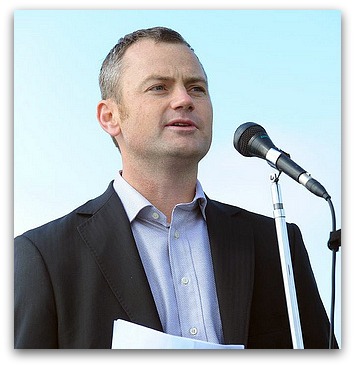 Simon Holmes à Court, Chairman, Hepburn Wind
Simon Holmes à Court, Chairman, Hepburn Wind
·
Editor’s comment: It’s worth reading Dr. Sarah Laurie’s response to the Hepburn Wind Farm fiasco. Turns out the “Hepburn Wind” crowd (including Simon Holmes à Court, Chairman of Hepburn Wind) were given explicit warning by Dr. Laurie and others about siting their turbines too close to people’s homes. The Hepburn Wind Gang turned a deaf ear. The result is casualties like the Frosts and Dr. Andja Mitric-Andjic—herself a victim of Wind Turbine Syndrome.
·
 ·
··
Hepburn Wind Chairman Mr Simon Holmes à Court was warned this was the inevitable consequence of locating turbines too close to homes in October 2010, before the turbines were constructed. I wrote to him informing him of this by email on 18th October, 2010 and was subsequently interviewed by a local journalist, who quoted a representative from Hepburn Wind saying that they were confident there would be no problems, “as there were plenty of studies showing there were no problems” and they had no intention of waiting until independent health studies were completed.
Hepburn wind representatives and directors cannot say they were unaware of the issues, and the possibility that their turbines might have this effect, because of where they were sited. They chose to ignore that advice at their peril, and have instead chosen to “shoot the messenger”.
Unfortunately, when I met with Mr Holmes à Court earlier this year, to plead with him to delay starting the turbines until a health study had been done, he admitted he had not read Dr Pierpont’s study, and proceeded to accuse me of scaremongering, both in a private meeting with him and publicly in the oral evidence he gave to the Australian Federal Senate Inquiry into Rural Wind Farms (Melbourne hearing 29/3/11, p. 54 onwards).
This conveniently ignores the fact that problems with wind turbines in Australia were being publicly reported well before I became aware of the problem in July 2010. For example, Dr David Iser was an Australian GP who documented cases in Toora in 2004 and notifed health authorities and the then government, but he was ignored.Trish Godfrey, the Waubra resident, had publicly discussed her problems on a number of occasions, well before July 2010.
“Clinical whistleblower” is a far more apt description than “scaremonger”, and I join the ranks of others such as Dr Amanda Harry (UK), Dr David Iser (Australia), Dr Nina Pierpont (USA), Dr Robert McMurtry (Canada), Dr Michael Nissenbaum (USA), Dr Chris Hanning (UK), Dr Mauri Johansson (Sweden), Dr Henning Theorell (Sweden), forty physicians in Quebec, Canada, who have petitioned the Quebec government to do health proper health studies, and numerous others including more recently Australian doctors such as Dr Andja Mitric-Andjic, Dr Max Whisson, and Dr Wayne Spring, the Sleep Physician at Ballarat who has seen a number of patients from Waubra.
We now have the dangerous situation of an Australian Federal Government hell-bent on implementation of a technology which is causing serious harm to health around the globe when it is sited inappropriately, yet no action has yet been taken on the findings of their own Federal Senate Inquiry, which recommended urgent research to investigate this problem. It’s full steam ahead, reminiscent of the Titanic…
The same government is using buckets of taxpayers’ money to advertise this new government policy, featuring Hepburn Wind in it’s advertisements for its government policies, while at the same time this well-intentioned “community-owned” (actually, it is shareholder-owned) wind development is driving people out of their homes of 30 years. And there are apparently 50 more such “community” wind developments planned across the country by Mr Holmes à Court and his colleagues. One can only hope that the others are more appropriately sited, based on good independent scientific study, not yet done, or a very conservative setback buffer. Why are they not apparently listening to the National Health and Medical Research Council’s own advice to adopt a “precautionary approach”?
No amount of well-intentioned wishful thinking on the part of the directors and investors in these community wind development initiatives will protect nearby residents from the deleterious effects of physical forces such as sound waves, particularly the extremely low frequency sound waves emitted by wind turbines, both airborne and seismic, and which are uniquely disturbing, and uniquely penetrating.
It is high time that Mr Holmes à Court and all the other directors of Hepburn wind faced up to their legal responsibilities as company directors, and took those responsibilities seriously, and did their due diligence with respect to the adverse health effects of these wind turbines. They need to ensure that the acoustics advisers they are using are indeed doing their job properly.
Already, after a very short time operating under the company Hepburn Wind, the turbines are causing harm to health, and have had a devastating impact particularly on one family living 500 metres away, with two of the family members being so severely impacted that they have had to move out, or go away, to get relief from the symptoms and problems they are experiencing.
ALL PREDICTABLE. And ALL PREVENTABLE with the safe siting of turbines, well away from homes.
We know from the Falmouth, Massachusetts (USA) experience, that just one turbine is enough to cause serious harm to human health, from the case reports of serious consequences for neighbouring residents, and visitors (including acoustician Rob Rand).
THE TIME FOR DENIAL OF SERIOUS HARMFUL EFFECTS OF THESE TURBINES IS OVER.
IF THEY ARE CONSTRUCTED BEFORE THE NECESSARY INDEPENDENT ACOUSTICS AND HEALTH STUDIES ARE DONE, THEY MUST BE CONSTRUCTED WELL AWAY FROM HUMAN HABITATION.
IN AUSTRALIA, THE LIMITS OF CURRENT REPORTS OF SYMPTOMS DIRECTLY ATTRIBUTABLE TO WIND TURBINES OPERATING (highly characteristic body vibrations and the nighttime waking in a panicked state with prolonged difficulty getting back to sleep) is 10 kilometres, which is why our Explicit Cautionary Notice has given this distance as the necessary buffer, based on current knowledge. As turbines increase in size and power generating capacity, this may well need to increase, because of the increase in low frequency sound generated (see Moller & Pedersen’s recent paper).
·
Dr Sarah Laurie
Medical Director, Waubra Foundation
Click here for Nina Pierpont’s interview with a horse breeder discussing the disastrous effects of wind turbines on his breeding mares (March 2010). (The breeder has asked for his name to be kept confidential.)
—Miriam Raftery, East County Magazine (8/21/11)
Like those proverbial canaries in the coal mine, chickens near wind farms may provide early clues to potential harm to health of humans and animals. That’s the contention of Hamish Cumming, a farmer battling proposed wind turbines near his home in New Zealand.
He has written a letter to East County Magazine seeking help from people living near wind farms locally (and in other locations) to document cases of shell-less eggs, dead chickens, or other animals that suffer internal hemmorrhaging.
The “humble chicken” is common in rural areas near wind farms and can be easily monitored, Cumming says. Chickens under stress may produce a soft-shelled or shell-less egg that can’t be laid, killing the chicken. Such incidents have been documented near wind farms, says Cumming, who has also collected examples of livestock and a dog that died from internal hemorrhaging near wind farms.
“There are reports from many wind farm locations that chickens within a 3 km distance from turbines exhibit shell-less eggs during some weather conditions,” he stated. “Some locations have reported shell-less eggs or dead chickens that coincide with residents’ complaints about “noisy nights” from turbines.”
In fact, shell-less eggs are also known as “wind eggs.” According to Broad Leys Publishing, which specializes in books for poultry owners, a yolk-less wind egg may occur in a young pullet, but “wind eggs can also occur in older hens if they are subject to sudden shock.”
Chickens aren’t the only species suffering ill health effects from living near wind farms, Hamish says. (See this and this and this and this and this and this and this and this and this and this—Editor.)
“So far there are several records of dairy cattle in Canada and Australia reducing milk output by as much as 30%,” he wrote.
The Discovery Channel ran a report on massive deaths among bats that suffered lung hemorrhaging when flying near wind turbines.
Goats in Taiwan, verified by the Taiwanese Department of Agriculture, have reportedly died due to stress-induced conditions within 2 km of turbines. “I have had reports of high levels of stillborn lambs and calves (up to 10%) . . . and stillborn horses in Australia and overseas, only after wind farms commenced operations,” he claims.
Wind farms may even be damaging to the family pet, he believes. “A dog was verified by Werribee Veterinary Hospital as dying from multiple organ fibrosis, believed to be stress-induced—and it was also within 2 km of turbines.”
Animals grazing near wind farms have also exhibited fibrosis, or hemorrhaging of major organs, when butchered, he observed. He believes this may explain why some native birds abandon habitat and cease breeding close to wind turbines.
That’s of serious concern to Cumming, who has endangered bird species nesting on wetlands at his New Zealand farm.
There have also been claims around the world of human health impacts in some communities near wind farms. Dr. Nina Pierpont, a Johns Hopkins University School of Medicine-trained physician and Princeton University PhD, has authored a book titled Wind Turbine Syndrome documenting serious health effects in people living near wind turbines due to low-frequency sound waves. The wind industry has disputed her findings.
Cumming seeks residents in East County and elsewhere around the world who live within 5 km of wind turbines to create a large data pool. Participants may already own chickens, or be willing to acquire them for the study. Cutting open a dead hen will expose the shell-less egg, if that is the cause of death, he said.
He seeks the following data:
1. How close the nearest turbines are to your chickens or slaughtered animals
2. How many turbines are within 5 km
3. Brand and size of the turbines
4. Name of the wind farm
5. Your country
Data may be sent to Hamish.cumming@bigpond.com
East County Magazine is also interested in hearing about local cases of animal hemmorrhaging, wind eggs, or human health issues from people living near wind farms in San Diego’s East County. Contact editor@eastcountymagazine.org.
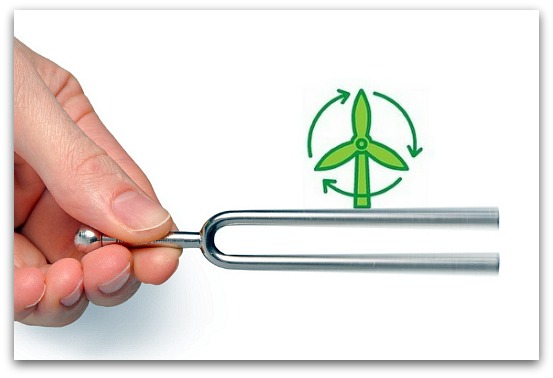 Editor’s note: This image was added by WTS.com
Editor’s note: This image was added by WTS.com
·
—Rob Edwards, guardian.co.uk (8/19/11)
The Ministry of Defence (MoD) is blocking plans for hundreds of wind turbines because it says their “seismic noise” will prevent the detection of nuclear explosions around the world.
The MoD claims that vibrations from new windfarms across a large area of north-west England and south-west Scotland will interfere with the operation of its seismological recording station at Eskdalemuir, near Lockerbie. The station listens out for countries secretly testing nuclear warheads in breach of the 182-nation Comprehensive Test Ban Treaty.
At a meeting today, Carlisle council rejected the latest application for six wind turbines at Hallburn Farm, near Longtown, because of the MoD’s objections. The noise from the turbines would increase interference to an unacceptable level, the MoD said.
The company that made the application, REG Windpower, warned that plans for many other windfarms in the area were similarly affected. As much as one gigawatt of renewable power was being held up by the MoD, the company told the Guardian.
This is equivalent to about a quarter of the UK’s current onshore wind capacity, and could make an important contribution to meeting UK targets to cut the pollution that is causing climate change, REG Windpower argued.
But according to the MoD, the swishing blades of wind turbines cause vibrations in the ground that can be detected by the sophisticated monitoring equipment at Eskdalemuir. The UK has an international obligation to protect the operation of the station to help prevent the spread of nuclear weapons, it said.
An expert study for the MoD concluded that although the station could cope with some seismic noise, increasing this beyond a certain level would cause interference. The limit has now been reached so the ministry is objecting to every new wind turbine within 50km of Eskdalemuir.
This has generated frustration among wind power developers because the area has many attractions for them. It has good wind speeds, is sparsely populated and is close to centres of electricity demand.
But REG Windpower’s development director, Matt Partridge, was hopeful of a breakthrough in finding a technical fix for the problem. “We’re optimistic there will soon be a solution,” he said.
One idea is to hang weights like pendulums inside turbine towers to deaden the vibrations from the blades. The MoD promised it would reassess its opposition if there were a proven technological solution.
Eskdalemuir was a “unique facility in the UK”, said an MoD spokesman. “It detects and accurately interprets seismic signals worldwide to detect nuclear explosions and deter the proliferation of nuclear weapons. Wind turbines can affect the readings.”
He added: “The MoD would not object to a planning application without due reason. Objections are only raised where such action is considered vital to adequately protect MoD interests.”
·
Editor’s note: For a relevant article, see Infrasound: Noise you can’t hear, but feel—over huge distances.
 Dr Mitric-Andjic
Dr Mitric-Andjic·
—Brendan Gullifer, The Courier (8/18/11) (The images used throughout this posting were supplied by WTS.com—Editor.)
·
A local doctor has spoken out publicly for the first time after treating patients for symptoms associated with living near wind turbines.
Dr Andja Mitric-Andjic, who practises in Daylesford, said she had treated at least two local patients for sleep deprivation, and spoken with others living near the Hepburn wind farm.
Dr Mitric-Andjic, who lives at Korweinguboora, said she, her husband and14-year-old son had also suffered sleep interruption since the turbines began operating.
Dr Mitric-Andjic said she decided to speak out because the problems being experienced by local residents could not be ignored.
“Wind farm, what do you mean wind farm?” she said.
“This is industrial. No one is against green energy. Everyone would say yes, of course, but put it out of residential areas.”
Dr Mitric-Andjic, 49, practises at Springs Medical Centre. She and her husband bought land on the Ballan-Daylesford Road seven years ago and built a house there last year.
She said patients had come to see her to complain about the noise from the two local turbines.
“They can’t sleep and in the morning they wake up exhausted. They can’t function. They have poor concentration, probably because of poor sleeping.”
Hepburn Wind chairman Simon Holmes à Court said any claims of adverse health effects would be taken “very seriously”.
“As a community organisation, we’re very concerned about the well-being of our community,” Mr Holmes à Court said.
“If anyone is concerned that the turbines are harming them, we want to meet to understand their claims. Our project officer lives in Leonards Hill and is in frequent contact with the community around the wind farm.”
Turbine landholder Ron Liversidge said any claims of noise problems were “completely false”.
Mr Liversidge said he had been doing his own noise monitoring, by parking his car on the road and listening.
“Anybody can come and listen for themselves,” he said. “I don’t believe there’s any problems whatsoever.”
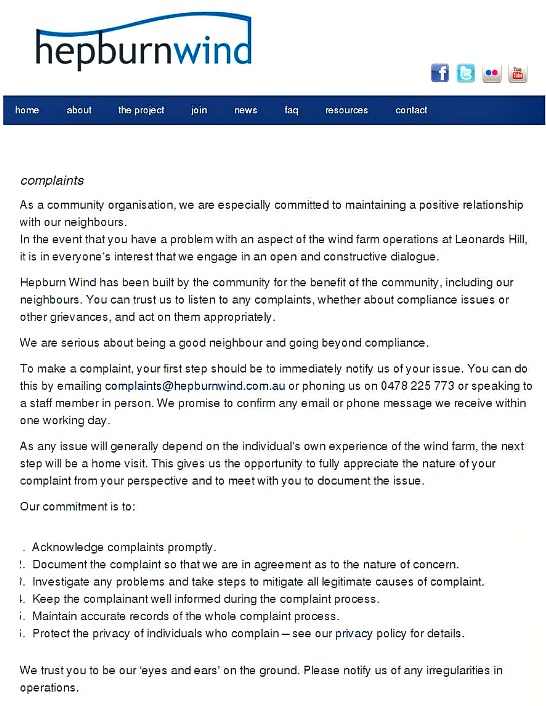 Click here for source on Hepburn Wind site
Click here for source on Hepburn Wind site»»»»»»»
·
Editor’s comment: Now for some real transparency in this whole sordid tale. The following rebuttal was written by Sarah Laurie, MD, Medical Director of the Waubra Foundation (Australia). Read her response to the “Hepburn Wind” crowd and see if you don’t agree that Hepburn’s “Complaint” process is nothing more than posturing and rhetoric (i.e., bullshit).
·
 ·
·Hepburn Wind Chairman Mr Simon Holmes à Court was warned this was the inevitable consequence of locating turbines too close to homes in October 2010, before the turbines were constructed. I wrote to him informing him of this by email on 18th October, 2010 and was subsequently interviewed by a local journalist, who quoted a representative from Hepburn Wind saying that they were confident there would be no problems, “as there were plenty of studies showing there were no problems” and they had no intention of waiting until independent health studies were completed.
Hepburn wind representatives and directors cannot say they were unaware of the issues, and the possibility that their turbines might have this effect, because of where they were sited. They chose to ignore that advice at their peril, and have instead chosen to “shoot the messenger”.
Unfortunately, when I met with Mr Holmes à Court earlier this year, to plead with him to delay starting the turbines until a health study had been done, he admitted he had not read Dr Pierpont’s study, and proceeded to accuse me of scaremongering, both in a private meeting with him and publicly in the oral evidence he gave to the Australian Federal Senate Inquiry into Rural Wind Farms (Melbourne hearing 29/3/11, p. 54 onwards).
This conveniently ignores the fact that problems with wind turbines in Australia were being publicly reported well before I became aware of the problem in July 2010. For example, Dr David Iser was an Australian GP who documented cases in Toora in 2004 and notifed health authorities and the then government, but he was ignored. Trish Godfrey, the Waubra resident, had publicly discussed her problems on a number of occasions, well before July 2010.
“Clinical whistleblower” is a far more apt description than “scaremonger”, and I join the ranks of others such as Dr Amanda Harry (UK), Dr David Iser (Australia), Dr Nina Pierpont (USA), Dr Robert McMurtry (Canada), Dr Michael Nissenbaum (USA), Dr Chris Hanning (UK), Dr Mauri Johansson (Sweden), Dr Henning Theorell (Sweden), forty physicians in Quebec, Canada, who have petitioned the Quebec government to do health proper health studies, and numerous others including more recently Australian doctors such as Dr Andja Mitric-Andjic, Dr Max Whisson, and Dr Wayne Spring, the Sleep Physician at Ballarat who has seen a number of patients from Waubra.
We now have the dangerous situation of an Australian Federal Government hell-bent on implementation of a technology which is causing serious harm to health around the globe when it is sited inappropriately, yet no action has yet been taken on the findings of their own Federal Senate Inquiry, which recommended urgent research to investigate this problem. It’s full steam ahead, reminiscent of the Titanic…
The same government is using buckets of taxpayers’ money to advertise this new government policy, featuring Hepburn Wind in it’s advertisements for its government policies, while at the same time this well-intentioned “community-owned” (actually, it is shareholder-owned) wind development is driving people out of their homes of 30 years. And there are apparently 50 more such “community” wind developments planned across the country by Mr Holmes à Court and his colleagues. One can only hope that the others are more appropriately sited, based on good independent scientific study, not yet done, or a very conservative setback buffer. Why are they not apparently listening to the National Health and Medical Research Council’s own advice to adopt a “precautionary approach”?
No amount of well-intentioned wishful thinking on the part of the directors and investors in these community wind development initiatives will protect nearby residents from the deleterious effects of physical forces such as sound waves, particularly the extremely low frequency sound waves emitted by wind turbines, both airborne and seismic, and which are uniquely disturbing, and uniquely penetrating.
It is high time that Mr Holmes à Court and all the other directors of Hepburn wind faced up to their legal responsibilities as company directors, and took those responsibilities seriously, and did their due diligence with respect to the adverse health effects of these wind turbines. They need to ensure that the acoustics advisers they are using are indeed doing their job properly.
Already, after a very short time operating under the company Hepburn Wind, the turbines are causing harm to health, and have had a devastating impact particularly on one family living 500 metres away, with two of the family members being so severely impacted that they have had to move out, or go away, to get relief from the symptoms and problems they are experiencing.
ALL PREDICTABLE. And ALL PREVENTABLE with the safe siting of turbines, well away from homes.
We know from the Falmouth, Massachusetts (USA) experience, that just one turbine is enough to cause serious harm to human health, from the case reports of serious consequences for neighbouring residents, and visitors (including acoustician Rob Rand).
THE TIME FOR DENIAL OF SERIOUS HARMFUL EFFECTS OF THESE TURBINES IS OVER.
IF THEY ARE CONSTRUCTED BEFORE THE NECESSARY INDEPENDENT ACOUSTICS AND HEALTH STUDIES ARE DONE, THEY MUST BE CONSTRUCTED WELL AWAY FROM HUMAN HABITATION.
IN AUSTRALIA, THE LIMITS OF CURRENT REPORTS OF SYMPTOMS DIRECTLY ATTRIBUTABLE TO WIND TURBINES OPERATING (highly characteristic body vibrations and the nighttime waking in a panicked state with prolonged difficulty getting back to sleep) is 10 kilometres, which is why our Explicit Cautionary Notice has given this distance as the necessary buffer, based on current knowledge. As turbines increase in size and power generating capacity, this may well need to increase, because of the increase in low frequency sound generated (see Moller & Pedersen’s recent paper).
·
Dr Sarah Laurie
Medical Director, Waubra Foundation
 ·
·Willem Post BSME (Bachelor of Science in Mechanical Engineering) New Jersey Institute of Technology, MSME (Masters of Science in Mechanical Engineering) Rensselaer Polytechnic Institute, MBA (Masters of Business Administration) University of Connecticut. P.E. Connecticut. Consulting Engineer and Project Manager. Performed feasibility studies, wrote master plans, and evaluated designs for air pollution control systems, power plants, and integrated energy systems for campus-style building complexes. Currently specializing in energy efficiency in buildings.
Contact: wilpost@aol.com
Sample text (the author’s numerous weblink “references” have been removed by WTS.com, for formatting reasons)
Does Wind Energy Pay?: Because Denmark is a MODERATELY windy country, and many of its wind turbines are older, less efficient units, . . . its national average wind capacity factor (CF) was 0.242 for the 2005 -2009 period, not high enough for a private enterprise to make money with wind power, unless the subsidies are great.
The newer, offshore wind turbine facilities have CFs approaching 0.40. However, because the installed cost is well over $4,000/kW and the O&M (Operation & Maintenance) is about 3 times that of Danish onshore wind turbines, it is doubtful their wind energy is more competitive than onshore wind energy.
For a private enterprise to make money with wind power, low installed cost, say $2,000/kW, low O&M (1/3 of offshore) and a capacity factor of about 0.40, such as in many areas of the Great Plains states in the US, are required for the costs of moderately-subsidized, newer wind turbine facilities to be competitive with electricity of existing coal, gas and nuclear plants. Such Great Plains wind energy would cost less than the cost of electricity of NEW coal, gas and nuclear plants.
The low capacity factor, the additional grid management efforts to deal with wind energy, the transmission losses of sending wind energy to Norway’s and Sweden’s hydro plants, the wind energy output management, the wind energy integration fees paid to Norway and Sweden, and the above-market-rate FITs all make Danish wind energy a money-loosing operation; some of the losses are hidden in government accounts and the rest is recovered by adding very high taxes to Danish residential electric rates. As a result Danish household electricity cost of (energy+taxes+fees)/kWh are the highest in Europe. The untaxed Danish COMMERCIAL electric rates are at about 1/3 of the residential rate; a government manipulation to advantage its industrial companies?
The Danish wind elite will not find it easy to own up to this in public, so they advise other nations to “do as we do” and “go offshore”; Vestas, their national wind champion, will do more business as a result.
If the Danes cannot make wind pay at a national CF of 0.242, the Dutch (CF 0.186) and the Germans (CF 0.167) will not be able to make it pay either.
Growing Opposition to Wind Turbines: As the Danes became aware, largely because of the internet, that the poor economics of their heavily-subsidized wind energy is a major reason for Denmark’s high residential electric rates, opposition to the 400-ft tall onshore wind turbines increased so much over the past 6 years that Dong Energy, the giant state-owned utility, finally announced in August, 2010, that it would abandon plans for new onshore wind turbines and that any future wind turbine development would be offshore. This may have elicited a sigh of relief from the Danish people and a feeling they have some control of their government after all.
The reason for the slowness of Dong Energy is to protect Vestas, a national champion; with government subsidies it became the largest such company in the world (GE is second). . . .
Wind Energy and Job Creation: In 2009, the Institute for Energy Research commissioned the Danish think-tank CEPOS (Centre for Political Studies) to report on electricity exports from Denmark and the economic impact of the Danish wind industry. The report states that Danes pay the highest residential electric rates in the European Union (partly due to subsidized wind power), and that the cost of saving a metric ton of CO2 between 2001 and 2008 has averaged $124. The report estimates that 90% of the jobs were transferred from other technology industries to the wind industry, and that 10% of the wind industry jobs were newly created jobs, and states that as a result, Danish GDP is $270 million lower than it would have been without wind industry subsidies.
Subsidized job creation and industry building are economic downers not only in Denmark, but elsewhere as well, including Vermont, as shown by the White Paper Report by the Vermont Dept. of Public Service.
Sample text (the author’s numerous weblink “references” have been removed by WTS.com, for formatting reasons)
Various government entities, eager to show their greenness regarding global warming, passed laws to subsidize renewable power, so-called “green power”, as if there is such a thing. Some governments even passed laws that declare hydropower as non-renewable, but, on reflection of its implications, reversed themselves and passed laws that declare hydropower IS renewable, as recently did Vermont’s legislature.
President Andrew Jackson, Democrat, Populist: “When government subsidizes, the well-connected benefit the most”. The renewables subsidies to the politically-well-connected often result in uneconomic wind power projects, some of which are described in this article.
Vendors, owners, financiers often claim “trade secrets”, whereas in reality they want to obfuscate wind power’s shortcomings, a too-generous subsidy deal, or other insider’s advantage. It would be much better for all involved, if there were public hearings and full disclosure regarding the economics of any project receiving government subsidies, to ensure the people’s funds receive the best return on investment.
EXAMPLE: UNIVERSITY of MAINE WIND POWER A DISMAL FAILURE?
The University of Maine, UM, decided to install a 600 kW wind turbine made by RRB Energy Ltd, an Indian company, at its Presque Isle Campus. Results from a 20-month wind resource assessment indicated the campus receives enough wind for a community wind project, not a commercial wind project.
Community wind power is defined as locally-owned, consisting of one or more utility-scale or a cluster of small turbines, totaling less than 10 MW, that are interconnected on the customer or utility side of the meter. The power is consumed in the community and any surplus is sent to the utilty which supplies power as needed.
The purpose was to generate power and to use the wind turbine as a teaching tool for the students. Because it is almost impossible to obtain operating data from the vendors, owners and financiers of wind facilities, UM, to its credit, decided to make available all of its wind turbine operating data.
Capital Cost and Power Production
Estimated capital cost $1.5 million
Actual capital cost $2 million; an overrun of 33%
The project was financed by UM cash reserves and a $50,000 cash subsidy from the Maine Public Utilities Commission.
Estimated useful service life about 20 years.Predicted power production 1,000,000 kWh/yr
Predicted capacity factor = 1,000,000 kWh/yr)/(600 kW x 8,760 hr/yr) = 0.190Actual power production after 1 year 609,250 kWh
Actual capacity factor for 1 year = 609,250 kWh/yr/(600 kW x 8,760 hr/yr) = 0.116; a shortfall of 39%
Value of power produced = 609,250 kWh/yr x $0.125/ kWh = $76,156/yr; if O&M and financing costs amortized over 20 years are subtracted, this value will likely be negative.Actual power production after 1.5 years 920,105 kWh
Actual capacity factor for 1.5 years = (920,105 kWh/1.5 yrs)/(600 kW x 8,760 hr/yr) = 0.117Operation and Maintenance
According to the European Wind Energy Association: “Operation and maintenance costs constitute a sizable share of the total annual costs of a wind turbine. For a new turbine, O&M costs may easily make up 20-25 percent of the total levelized cost over the lifetime of the turbine.”
Power Used by the Turbine (Parasitic Power)
Parasitic power is the power used by the wind turbine itself. During spring, summer and fall it is a small percentage of the wind turbine output. During the winter it may be as much as 10-20 % of the wind turbine output. Much of this power is needed whether the wind turbine is operating or not. At low wind speeds, the turbine power output may be less than the power used by the turbine; the shortfall is drawn from the grid.
Two little-wind days were selected; a summer day and a cooler winter day to show that in summer the parasitic power is less than in winter. In winter, the wind speed has to be well above 4.5 m/s, or 10.7 miles/hour, to offset the parasitic power and feed into the grid. Speeds less than that means drawing from the grid, speeds greater than that means feeding into the grid.
This will significantly reduce the net power produced during a winter. On cold winter days, even at relatively high wind speeds of 10.7 miles/hour, or greater, power is drawn from the grid, meaning the nacelle (on big turbines the size of a greyhound bus) and other components require significant quantities of electric power; it is cold several hundred feet above windy mountain ridges.
14 May, 2010, wind speed 2.9 m/s (6.9 miles/hour), net power output -0.3 kW.
20 Nov, 2010, wind speed 4.5 m/s (10.7 miles/hour), net power output -5.6 kW.
Below is a representative list of equipment and systems that require electric power; the list varies for each turbine manufacturer.
– rotor yaw mechanism to turn the rotor into the wind
– blade pitch mechanism to adjust the blade angle to the wind
– lights, controllers, communication, sensors, metering, data collection, etc.
– heating the blades during winter; this may require 10%-20% of the turbine’s power
– heating and dehumidifying the nacelle; this load will be less if the nacelle is well-insulated.
– oil heater, pump, cooler and filtering system of the gearbox
– hydraulic brake to lock the blades when the wind is too strong
– thyristors which graduate the connection and disconnection between turbine generator and grid
– magnetizing the stator; the induction generators used to actively power the magnetic coils. This helps keep the rotor speed constant, and as the wind starts blowing it helps start the rotor turning (see next item)
– using the generator as a motor to help the blades start to turn when the wind speed is low or, as many suspect, to create the illusion the facility is producing electricity when it is not, particularly during important site tours. It also spins the rotor shaft and blades to prevent warping when there is no wind.
Conclusions
The huge difference between predicted and actual capital cost and capacity factor would be disastrous for a commercial installation. Because this is for “teaching purposes” such a detail is apparently not that important. The capital cost and any operating costs in excess of power sales revenues will likely be recovered by additions to tuition charges.
UM should find less expensive ways to educate students in all areas, not just wind power. Cost per university student in the US is already well over 2 times that of Europe, a competitive disadvantage.
Sample text (the author’s numerous weblink “references” have been removed by WTS.com, for formatting reasons)
The New England Electric Grid, NEEG, managed by ISO New England, ISO-NE, has a generating capacity of about 34,020 MW, electrical energy supplied to the grid is about 130,000 GWh/yr. It includes over 350 central power plants and 8,000 miles of high-voltage transmission lines to serve about 6.5 million customers. The supply to 2010 NEEG is 55.4% from CO2-producing fossil fuels (44% gas, 11% coal, 0.4% oil), 29% from CO2-free nuclear, 6.2% from CO2-free hydro, 3.3% from interstate transfers, 3% from CO2-producing wood waste, 2.4% from CO2-producing solid waste and 0.7% from Other i.e., CO2-free wind, solar, etc. Almost all of this energy is STEADY and the T&D systems of the NEEG are designed accordingly.
Historically, electric grids have experienced varying electric demands during a day and varied the output of their generating plants to serve that demand and, at the same time, regulate frequency.
Cold, quick-starting, quick-ramping peaking plants, such as a mix of gas-fired OCGTs and CCGTs, are turned on and off each day to serve normal daily peak demands which occur once or twice per day. From a cold start, CCGTs take about an hour before there is enough steam pressure to operate the steam cycle. During this hour they run as OCGTs at about 30 to 35% efficiency, instead of the 55 to 59% efficiency as CCGTs.
Base-loaded coal and nuclear plants, which take about 6-12 hours from a cold start to rated output, are less suitable for variable output operation. Usually they operate near rated output for about a year for coal plants, for about 1.5 years for nuclear plants, after which they are shut down for 3-4 weeks for maintenance and refueling.
Base-loaded coal plants, designed for most economical, least polluting, steady operation near rated output, are often used to follow daily demand profiles and are sometimes used for the frequent, rapid balancing operations to accommodate wind energy; the coal plants used for such balancing operations need to be designed for ramp rates of 5-10 MW/min for a 500 MW plant.
Balancing operations of coal plants require more fuel per kWh and emit more pollutants, including SOX, NOX, CO2 and particulate per kWh, as shown by coal plants used for balancing in Colorado, Texas, etc. The main reason utilities use coal plants for balancing is because they lack sufficient capacity of hydro plants and gas-fired OCGT and CCGT plants to accommodate the mandated “must-take” wind energy.
Base-loaded nuclear plants, designed for most economical, steady operation near rated output, are very rarely used for balancing operations. They typically have capacity factors, CF, of 0.90 or greater.
Increased wind energy penetration will present additional challenges to grid managers, such as ISO-NE. Because wind energy is variable and intermittent, additional spinning, quick-ramping units, such as a mix of OCGTs and CCGTs, must be kept in 24/7/365 operation to supply and withdraw energy as required. The units must respond to changes of:
– demand of millions of users during a day.
– supply, such as from unscheduled plant outages.
– supply due to weather events, such as lightning, icing and winds knocking out power lines.
– supply from wind turbine facilities.If these changes, especially those due to wind energy, are of high MW/min, the CCGTs may have to temporarily operate as OCGTs, because their heat recovery steam generators, HRSGs, would be damaged by the frequent, rapid, high amplitude balancing; HRSGs have lower ramp rates than OCGTs. This increased OCGT mode of operation increases fuel consumption, NOX and CO2 emissions per kWh.
An example of what ISO-NE may have to look forward to: California’s wind and solar generating capacity will increase significantly in the near future largely due to government subsidies and “must-take” mandates. The management of their variable power on the grid is anticipated to be a significant grid operating challenge as:
– predicting day-ahead wind and solar outputs remains elusive, even with weather prediction systems
– sufficient balancing capacity of flexible generating units, such as OCGTs and CCGts, is not available at present
– the grid structure lacks the required transmission flexibility.The US Energy Information Administration projects levelized production costs (national averages, excluding subsidies) of NEW plants coming on line in 2016 as follows (2009$) :
Offshore wind $0.243/kWh, PV solar $0.211/kWh (significantly higher in marginal solar areas, such as New England), Onshore wind $0.096/kWh (significantly higher in marginal wind areas with greater capital and O&M costs, such as on ridge lines in New England), Conventional coal (base-loaded) $0.095/kWh, Advanced CCGT (base-loaded) $0.0631/kWh.
Sample text (the author’s numerous weblink “references” have been removed by WTS.com, for formatting reasons)
The Green Mountain Power-proposed 63 MW Lowell Mountain wind turbine facility with (21) 3 MW Danish, Vestas V-112 wind turbines, 373-ft (112 m) rotor diameter, 280-ft (84 m) hub height, total height (280 + 373/2) = 466.5 ft, stretched along about 3.5 miles of ridge lines, has nothing to do with community-scale wind, everything with industrial, utility-scale wind. The housings, 47 ft (14 m) long, on top of the 280-ft towers are the size of a Greyhound bus.
The GMP name for this facility is “Kingdom Community Wind”. GMP is using blatantly deceptive PR to soft-soap/deceive Vermonters.
GMP claims to be all about renewables, but it recently entered into an agreement with the Seabrook nuclear power plant to buy 60 MW of steady, 24/7/365, CO2-free nuclear energy at 4.66 cents/kWh, about half the cost of the Lowell wind energy which is variable and intermittent and only partially CO2-free, because it requires gas-fired, CO2-producing, quick-ramping balancing plant energy to make it useful for use on the grid. See below.
Gaz Metro of Quebec, Canada, owns GMP. It recently accquired Central Vermont Public Service Corporation. It now controls at least 70% of Vermont’s electrical energy market.
The wind energy production would be about 63 MW x 1 GW/1,000 MW x 8,760 hr/yr x capacity factor 0.32 = 176.6 GWh/yr, or 176.6/6,000 x 100% = 2.94% of Vermont’s annual consumption.
The capital cost of the wind turbine facility would be at least 63 MW x $2,500,000/MW = $157.5 million, excluding grid modifications.
The Lowell wind turbine facility facility would have a 20 – 25 year useful service life. However, gearboxes and blades sometimes fail within 5-10 years.
The CF of 0.32 and the $2,500,000/MW are the averages of recently-built, ridge line wind turbine facilities in Maine.
The average CF = 0.32 of the Maine wind turbine facilities was determined from public data provided by project developers. Actual CFs are a closely guarded business secret. It would be better if a project receives public subsidies, all operating data were required to be made public to ensure the public’s money is not wasted on non-viable projects, as often happens because of political inside dealing.
On ridge lines the terrain upstream of the rotor usually creates non-uniform wind speeds and turbulence which can significantly reduce the capacity factor of a wind turbine, especially if it has a very large diameter rotor. Also, the wind speed at the tip of one blade may be considerably greater than the wind speed at the tip of another creating additional stresses on the equipment. This is less the case on the flat plains of Kansas or offshore.
The reality is the Lowell Mountain wind turbine facility would be a capital intensive, highly-visual, noisy facility (100 dB(A) minimum, 106.5 dB(A) maximum) that is proposed to be built on environmentally-sensitive ridge lines. The wind turbines would be about 466.5 feet tall, equal to a 40-story building, with noise-making rotors.
People living within about 2 miles would be disturbed by an around-the-clock machinery noise and an irregular, throbbing, whoosh-type sounds, especially during nighttime. The noise will be similar to (21) Greyhound buses spread out on 3.5 miles of ridge lines on top of 280-ft towers simultaneously and continuously running their engines at a distance, 24/7/365 for 20 or more years; a total madness cooked up by GMP, aided and abetted by its minions in Montpelier. See “Increased Energy Efficiency” below.
Decision makers in Montpelier are far away from it all. They will likely not heed the complaints from those who live near the facility. They will certainly not heed the complaints from the fauna and flora currently inhabiting this pristine ridge line. Because of them, Vermonters are in danger of losing an international reputation of being preservers of their environment, in danger of losing a part of their soul.
Sample text (the author’s numerous weblink “references” have been removed by WTS.com, for formatting reasons)
As the US moves to increased use of renewable energy to reduce CO2 emissions, it is important to recognize efficient technologies, such as gas-fired, advanced, 60%+ efficient, combined cycle gas turbines, CCGTs, that emit about one third the CO2 per kilowatt-hour of a coal plant.
The more cost effective renewables should have incentives towards deployment. The less cost effective renewables should have incentives towards further development.
An undesirable situation would arise if politically-inspired deployment would occur prior to a renewable being ready for deployment, as was, and still is, the case with ethanol-from-corn which costs not only billions of dollars in subsidies each year, but does not even reduce CO2 emissions; a most egregious policy disaster. . . .
Levelized Costs of Energy: A partial list
The US Energy Information Administration projects levelized production costs (national averages, excluding subsidies) of NEW plants coming on line in 2016 as follows (2009$) :
Offshore wind $0.243/kWh; PV solar $0.211/kWh (significantly higher in marginal solar areas, such as New England); Onshore wind $0.096/kWh (significantly higher in marginal wind areas with greater capital and O&M costs, such as on ridge lines in New England; significantly lower in the Great Plains states); Conventional new coal (base-loaded) $0.095/kWh; Advanced 60%+ efficient CCGT (base-loaded) $0.0631/kWh.
Onshore Wind Energy Is Expensive
Kibby Mountain Wind Turbine Facility: TransCanada Power which owns the 132 MW Kibby Mountain Wind Facility in Maine has a 10-yr PPA with NStar, an electric utility, at a flat $0.105/kWh, plus the associated renewable energy certificates.
Power production is estimated at 132 MW x 8,760 hr/yr x CF 0.31 = 0.357 GWh/yr.
Capital cost is estimated at $320 million, or $2,424/kW.
The Kingdom “Community” Wind Project: The Green Mountain Power-proposed 63 MW Lowell Mountain wind turbine facility with (21) 3 MW Danish, Vestas V-112 wind turbines, 373-ft (112 m) rotor diameter, 280-ft (84 m) hub height, total height 466.5 ft, stretched along about 3.5 miles of ridge lines. The housings, 47 ft (14 m) long, on top of the 280-ft towers are the size of a greyhound bus.
With subsidies the levelized energy cost would be about $0.096/kWh, according to GMP
Power production is estimated at 63 MW x 1 GW/1,000 MW x 8,760 hr/yr x CF 0.32 = 176.6 GWh/yr
Capital cost is estimated at 63 MW x $2,500,000/MW = $157.5 million, excluding grid modifications.
Useful service life is estimated at 20 – 25 year. However, gearboxes and blades sometimes fail within 5-10 years. Standard manufacturer warrantees of blades and gear boxes are about 2 years.
Offshore Wind Energy Is Very Expensive
Cape Wind: Cape Wind Associates, LLC, plans to build and operate a wind facility on the Outer Continental Shelf offshore of Massachusetts. The wind facility would have a rated capacity of 468 MW consisting of 130 Siemens AG turbines each 3.6 MW, maximum blade height 440 feet, to be arranged in a grid pattern in 25 square miles of Nantucket Sound in federal waters off Cape Cod, Martha’s Vineyard, and Nantucket Island; the lease is for 46 square miles which includes a buffer zone.
The Massachusetts Department of Public Utilities approved a 15-yr power purchase agreement, PPA, between the utility National Grid and Cape Wind Associates, LLC. National Grid agreed to buy 50% of the wind facility’s power starting at $0.187/kWh in 2013 (base year), escalating at 3.5%/yr which means the 2028 price to the utility will be $0.313/kWh. The project is currently trying to sell the other 50% of its power so financing can proceed; so far no takers.
A household using 618 kWh/month will see an average wind power surcharge of about $1.50 on its monthly electric bill over the 15 year life of the contract; if the other 50% of power is sold on the same basis, it may add another $1.50 to that monthly bill.
Power production is estimated at 468 MW x 8,760 hr/yr x CF 0.39 = 1.6 GWh/yr.
The capital cost is estimated at $2.0 billion, or $4,274/kW. Federal subsidies would be 30% as a grant.
Block Island Offshore Wind Project: The 28.4 MW Block Island Offshore Wind Project has a 20-yr PPA starting at $0.235/kWh in 2007 (base year), escalating at 3.5%/yr which means the 2027 price to the utility will be $0.468/kWh. A State of Rhode Island suit is pending to overturn the contract; the aim is to negotiate to obtain a lower price.
Power production is estimated at 28.4 MW x 8,760 hr/yr x CF 0.39 = 0.097 GWh/yr.
Capital cost is estimated at $121 million, or $4,274/kW. Federal subsidies would be 30% as a grant.
Delaware Offshore Wind Project: The 200 MW Delaware Offshore Wind Project has a 25-year PPA starting at $0.0999/kWh in 2007 (base year), escalating at 2.5%/yr which means the 2032 price to the utility will be $0.185/kWh.
Power production is estimated at 200 MW x 8,760 hr/yr x CF 0.39 = 0.68 GWh/yr.
Capital cost is estimated at $855 million, or $4,274/kW. Federal subsidies would be 30% as a grant.
·
—Calvin Luther Martin, PhD
At a recent meeting with a group of people in the State of Maine, Nina Pierpont was asked to provide a list of questions that would help identify whether people living near wind turbines are suffering from Wind Turbine Syndrome. She agreed to do so, and this is the result. Click here.
The questionnaire begins with the following:
Interview for wind turbine victims
Note: This is designed to be an interview, providing guiding questions to a person being audio- or video-taped. It is not meant to be a questionnaire that a person fills out about him- or herself.
“Could you describe what you (or your child or other family members) have felt or experienced since the turbines started operating near your home?”
Let the person talk. Keep track on this checklist whether the person has covered each symptom area. Prompt with specific questions if the person does not cover these symptoms spontaneously, and encourage comparison to the past before turbines or to any periods away from home.
You are welcome to use this as you wish. We encourage you to send your results to us at WTS.com, so we can report on them.
—Calvin Luther Martin, PhD
Infrasound continues to mystify many readers of this website. That’s a pity, because infrasound is the chief cause of Wind Turbine Syndrome (WTS). If you don’t grasp the nature of infrasound, you’re going to have difficulty grasping WTS.
What we find, in particular, is that many people don’t appreciate how far infrasound can travel. The answer is, “far!” Even, “very far!”
Scroll to the bottom of this page and watch “The Sounds of Silence” by PBS’s Wired Science, explaining the remarkable propagation qualities of infrasound. Pay close attention to the section where geophysicist, Dr. Milton Garces, sets up a small fan in a home—actually, a rotary sub-woofer, in some respects much like a wind turbine—whose oscillating blades produce infrasound. (“It displaces a lot of volume—of air molecules—by shifting the pitch of the blades of the fan,” explains Garces.) Notice how the infrasound—a 1 Hz pressure wave, in this instance—radiates through the walls of the house, and beyond.
Now, ponder those huge (and getting huger) “rotary sub-woofer” wind turbines being built 1500 feet or a mile from your home. Or even several miles.
What turbines do is not only produce infrasound, but extremely strong bursts of infrasound—extremely strong & rapid (many times a second) bursts of pressure. And that, dear reader, is undoubtedly the chief reason why people become ill.
Behold, Wind Turbine Syndrome: extremely strong bursts of infrasonic pressure, radiating very far—through every barrier you can imagine. As far as the vestibular organs of the inner ear are concerned—organs honed by Mother Nature over millions of years to respond to subtle pressure waves, to tell us (a) where we are in space and (b) control our spatial reasoning and cognition, and (c) to pinpoint our split-second sense of balance and motion—this is catastrophic.
Pierpont explains all this in detail in her book, “Wind Turbine Syndrome,” wherein she notes that you, dear reader, are the guinea pig in (what’s called in biology) a “natural experiment” being conducted by Big Wind. (Read, “Your Guide to Wind Turbine Syndrome: A roadmap to this complicated subject.”)
My advice? Forget about suing the bastards, and forget about trying to present scientific proof to your town board (or any other government agency). Your board is likely composed of knaves who were compromised at least a year ago by the wind developers (with turbine leases). Instead, get mad. Stay mad. Make history. After 8 years of running this website and reporting ad nauseum on this outrage, I say it’s time for civil disobedience. Almost ludicrously and certainly tragically, it’s the only recourse offering any realistic hope of accomplishing something significant at this point in the Great Wind Energy Circus.
·
·
(With appreciation to Frank Dehnke, Germany, for bringing this video to our attention.)
“Psychologists are increasing awareness of the harmful effects noise has on cognition and health”
—Amy Novotney, Monitor on Psychology, July/August 2011, vol. 42, no. 7, pp. 46-49 (Note: The Monitor on Psychology is a publication of the American Psychological Association.)
·
We’ve all been annoyed by a neighbor’s late-night partying or early-morning lawn mowing. But it turns out that living in a noisy neighborhood particularly one plagued by train horns blaring or airplanes overhead—is more than exasperating. It might actually be deadly, according to a report released in April by the World Health Organization and the European Commission’s Joint Research Centre.
A steady exposure to “noise pollution;’ the report concludes, may lead to higher blood pressure and fatal heart attacks. The report analyzed a large number of epidemiological studies, most of which were conducted in Europe.
The report also confirmed what several psychologists have known for decades: Chronic noise impairs a child’s development and may have a lifelong effect on educational attainment and overall health. Numerous studies now show that children exposed to households or classrooms near airplane flight paths, railways or highways are slower in their development of cognitive and language skills and have lower reading scores.
“There is overwhelming evidence that exposure to environmental noise has adverse effects on the health of the population,” the report concludes, citing children as particularly vulnerable to the effects of chronic urban and suburban racket.
As air traffic increases worldwide and politicians consider building noise-producing wind turbines in more residential neighborhoods (see “Noise isn’t always loud,” below), the negative effects of noise will only continue to grow unless more is done to abate it, says environmental psychologist Arline Bronzaft, PhD, of the City University of New York. Her now-classic study from the 1970s was among the first to report the harmful effects of subway noise on children’s learning, and she has advised four New York City mayors on noise policy. New noise research in the United State has been scarce, however, since nearly 30 years ago federal funding for noise pollution research was cut after the U.S. Environmental Protection Agency’s Office of Noise Abatement and Control was eliminated during the Reagan administration . . . (click here to continue reading from the source).
Noise isn’t always loud
Another spate of psychological research is exploring the psychological and health effects of quieter—albeit constant—noise from wind farms. While these turbines are typically many decibels lower than the noise emitted by busy city traffic, power lawn movers or leaf blowers, sounds don’t have to be loud to be disturbing or to decrease quality of life, says Bronzaft.
“A dripping faucet may not measure that loud, but it sure can keep someone awake,” says Bronzaft, who has testified on the hazards of noise to government and health organizations in the United States and Canada and served as an expert witness in court cases on wind turbine noise.
Since the technology is still relatively new, a strong link between wind turbine noise and impaired human behavior or performance has yet to be proven—and the lack of federal funding means that research is unlikely to remedy this anytime soon.
Yet several small case studies and observational interviews have found an increase in sleep disturbance, psychological stress and headaches among those who live near the structures, according to New York pediatrician Nina Pierpont, MD, PhD.
Pierpont documents the individual experiences of families in Canada, Europe and the United States who live within several miles of the windmills in “Wind Turbine Syndrome: A Report on a Natural Experiment” (2009), and advocates for more research on the health effects before additional harm is done.
Yet some experts, including Robert J. McCunney, MD, a staff physician at Massachusetts General Hospital, argue that to establish a better connection between wind turbines and health, an individual’s health status must be studied before and after the windmills are installed [Pierpont in fact did this in her report; it’s called a case cross-over study—Editor], and the research should be peer reviewed [Pierpont’s book was in fact peer reviewed—Editor].
In addition, in 2009, a panel of independent experts [Hired by Big Wind, the members of this panel were hardly “independent” and, although they may have been generic experts in their respective disciplines, they were certainly not experts in this inquiry. Not one of them had ever interviewed a Wind Turbine Syndrome victim and, furthermore, not one of them had read Pierpont’s book before trashing it. “Experts” don’t behave this way—Editor] in public health, audiology and medicine commissioned by the American and Canadian Wind Energy Associations looked at peer reviewed studies on the health effects of wind turbines [They found no “peer reviewed” studies because—drum roll, please!—the recognition of the syndrome being so new, no one had published on it, except for Pierpont, and they blew her off without reading her book—Editor] and found that while some people might be annoyed by the “swish, swish” sound of the windmills, no medical basis existed for the health complaints that often arise near large wind-farm projects [Precisely the conclusion one would expect from a “study” commissioned and paid for by the two big wind energy associations—Editor].
“The sounds emitted by wind turbines are not unique,” panelists, including McCunney, contend in their review. “There is no reason to believe, based on the levels and frequencies of the sounds and the panel’s experience with sound exposures in occupational settings, that the sounds from wind turbines could plausibly have direct adverse health consequences.” [Click here to read Pierpont’s blistering critique of McCunney’s attempt at science—Editor.]
Still, Bronzaft’s efforts- along with a continued focus by psychologists around the world on noise pollution research and on teaching psychology students about the potential negative effects of noise- can help to increase society’s understanding of how to help abate chronic noise.
—A. Novotney [Note to Ms. Novotney: Why didn’t you contact Dr. Pierpont and interview her? You interviewed McCunney—why not Pierpont?—Editor.]
»»»»»»
·
Too many people on the earth. Too few
who hold the oak door open, or who nod
to the passing stranger as to the passing god.
Look from the stars and you will see whereto
this hungry fungus, man, has spread his drab
compactions, and is spreading, till the space
made rich by nature for his ease and grace
is petrified, as fruit is by a scab.
Packed on this dwindling planet, famished, men
will push and fight like beasts. No grandeur then,
no high design, no epic dream, no play,
no poised serenity in what they say
nor reasoned kindness in the things they do.
This is not fancy, this is deathbed true.
—Max Eastman
·
Editor’s note: The following video was sent to WTS.com by this group, with the following message:
http://www.ibrahimkavagi.org No Wind farms! Yaşam alanlarımızda Rüzgar Çiftliği istemiyoruz! (We do not want our fields of Life Wind Farm!)
Address: Ibrahimkavağı Village / Cine / Aydin / TURKEY
If you open the link, you’re taken to the following video. You don’t need to understand Turkish to understand what’s going on. These people are getting arrested for opposing a windfarm next to their village. (Sound familiar?) Notice their civil disobedience: refusing to disperse when the cops arrive.
VALİ GELMEDEN, ASKERLER GELDİ!.. from İbrahimkavağı Köyü Platform on Vimeo.
·
The following is a screenshot of their website, using Google Translate (which gives a very rough translation, in this case).
·
This is likewise taken from the website, again using Google Translate. (Notice the text is cut off at the bottom, simply because I couldn’t get the entire text on my screen—and I didn’t want to scroll it.)
Editor’s note: Sue Hobart, author of this letter, occupies the home wherein two professional acousticians became debilitatingly ill with Wind Turbine Syndrome (WTS).
Robert Rand (Brunswick, Maine) and Stephen Ambrose (Windham, Maine) were hired by Sue and her husband to measure noise/vibration from the industrial wind turbine next door. Rand & Ambrose have been in the business for decades. Ambrose is Board Certified by the Institute of Noise Control Engineering (INCE); Rand is a Member of INCE. Both men had taken noise/vibration measurements at other wind turbine sites. Neither had experienced WTS before. Both were flabbergasted by the experience, even as it was happening to them. They basically had to flee the home.
Sue, unfortunately, can’t do that; she is being forced to move out.
When Robert Rand met Nina Pierpont recently, he shook her hand, looked her in the eye and declared, “”Nina, what you wrote about in your book is real! Thank you!”
·
·
Dear Falmouth (Mass.) Board of Selectmen,
The wind turbine issue rolls on, and my health is rapidly failing. I am in the acoustic range of the Webb turbine (see Dan Webb, below), and am trying to make plans to have some sort of future. I need to know if anybody is going to hear, or pay attention to, anything I have to say.
I have closed my business for next year, and am just barely making it, physically, this season. I’m in pain and can’t think clearly. I never sleep. I work out of my home.
Life as I knew it is over.
I sleep in the middle of my dark basement. Even so, I still vibrate and ache all the time. I have headaches all the time, and the only time they stop is when I am away from my home for 12 hours or more.
I have to give up my home because there is absolutely no possibility of any kind of restful or meaningful life, here, when that turbine is turning—which is just about all the time. Occasionally there are several hours it is off—and I become human again. I celebrate those few hours—but then they leave.
You have absolutely no idea how horrible this situation is. I cry and grieve every day for all that has been taken away, here.
There is talk and talk about caring, but I just don’t believe you. It seems nobody actually wants to take responsibility for this horrendous mistake.
In the meantime, how does Dan Webb get off having that thing (wind turbine) paid for by grants, then selling it to himself, locking it up in a limited liability corporation, and dancing off with all the profits in his pocket?
Is his permit grandfathered? Is that turbine up for good, no matter what?
You see, I don’t have his millions to fight him. I just have 6 acres and a nice, un-sellable home.
My life will most likely be spent in a van or a rental, now, because my house is toxic to me.
Whatever. I never get any answers, anyway. Have a fun barbecue and sailing trip and community dinners at the Coonamessett Inn and cocktail parties, hobnobbing about and patting yourselves on the back for being “progressive.” Apparently, that’s what matters more than quality of life, anyway.
I can’t wait till my wedding floral business is over, so I can get out of here and sleep again.
Make no mistake, however; this is your mistake to correct!
Even so, I expect the same response I always get. Silence.
Sue Hobart
Hobart’s Fine Florals
476 Blacksmith Shop Road
East Falmouth MA 02536
508-548-5226
508-737-1450 cell
—Brad Blake (Cape Elizabeth, Maine)
Annie went to Rockland (Maine) with me today, to a protest against the proposal for a huge off-shore wind project in the Gulf of Maine, which will be an immensely expensive waste of taxpayers’ money and will send electricity rates through the roof.
She was amazed at my ability to speak extemporaneously, but she caught on and I proudly watched my daughter talk effectively to people and hand out brochures.
A “chip off the old block”!
·
Editor’s note: The following satire was composed by a friend of mine. For the past 6 months or so, Tom Whitesell has been battling Iberdrola in St. Lawrence County, New York.
Tom wrote this after sending me an email about a surreal public meeting he attended the other evening, a meeting between a gang of Iberdrola reps, on the one hand, and farmers on the other.
Something seemed to snap within Tom at the meeting. “Snap,” as in “this meeting is so bizarre, it’s right out of Alice in Wonderland!”
I wrote back the following, explaining Wind Turbine Syndrome by Proxy.
There are two forms of Wind Turbine Syndrome. Both are nasty. One, the most commonly understood manifestation, comes from living too close to turbines. The other, less discussed and barely researched, is Wind Turbine Syndrome by Proxy. WTSp.
You’ve got WTSp. Bad. Me too. I’ve had it for years. I’m in remission. You’re not in remission; you’ve got a fulminant case.
WTSp is contracted by listening to too many “windies” or wind developers at meetings. Your symptoms are classic. Eventually you will recover. Well, sort of. Recovery is only partial, because WTSp leaves one with PTSD—and that’s incurable.
To which Tom responded:
I appreciate your diagnosis. It seems dead-on. A kind of chronic, sometimes dormant irritation. Sometimes it flares up as depression, sometimes as anger. Sort of like shingles. Sometimes it gets really bad.
I wrote you a story (see attached) about the meeting. I think it conveys the credibility and substance of the meeting pretty clearly.
·
·
Dear Mr. Martin,
I wrote a story. Here it is.
On Monday night I went to a meeting with my friend Anne. There were people from the town, and 10 officials from the two towns, and 6 nice people from a company, Iberdrola. The 10 officials were sitting in a row behind a long table at the front of the room. Their lawyer was in the middle of the row. There was another long table along the side of the room where the nice people were sitting. We sat in chairs out in the room called the town hall.
The nice people from the company were so happy. They talked and talked. I think they know everything. After a long time the man called the supervisor said the people from the town could ask questions. He said each person could ask a question for 3 minutes, and the people from the company could talk as long as they wanted to. Anne said that wasn’t fair.
The pretty lady called Jenny talked a lot. I think she was really happy. She wanted to make everybody feel happy. There was a man called an environmental engineer, and a lawyer. The lawyer talked really fast. Sometimes his voice got louder. I think he got really excited sometimes, mostly when he thought one of the people from the town didn’t understand. He was a little bald man with glasses. His name was Mark Epstein. There was an environmental engineer. And a project licensing manager, and a weather expert.
One of the people from the town said something about infrasound and people getting sick. The environmental engineer said a lot of the company experts talked together, and they decided that infrasound doesn’t hurt people. That’s all he said. One of the people asked how much money the town would get, and another asked how much his taxes would go down. The lawyer said he didn’t know. He said that alot. He talked about it for a long time but I didn’t understand. Mostly I think he answered the people’s questions but talked about other things. He wanted us to be happy.
Some funny things happened. One time when Jenny was talking, she said that everything they do is transparent. Transparent means you can see through it. Then I looked at Jenny and I could see right through her! And then I could see right through all of the nice people from the company. It was like magic. Sometimes one of the supervisor men barked at people from the town. I thought he was a dog. But that doesn’t seem possible. He looked like a man.
Anne and I were writing things on paper. We wrote some jokes. Anne said the lady next to her was reading what she wrote. Then she said the man behind me was reading what I wrote. Anne ran out of paper. She turned her paper over. The other side was covered with writing. She started writing in the spaces in between. She wrote “can you read between the lines?”
One of the farmers from the town said he knows what manure smells like. I’m not sure what he meant.
Anne said one of the supervisors was staring at her. Later she said the town’s lawyer, Mr. Linden, was staring at her. She hadn’t talked. She was just sitting there listening. A girl told me once that when a boy stares at a girl it means he likes her. Maybe those men like Anne. I think they are glad she went to their meeting because she knows so much.
I like that nice book by Mr. Huxley, called Brave New World. It says that we don’t have to worry, because they are taking care of us, so we can feel good.
I like the windmills. I think they are pretty.
The people from the company want to build windmills here. I wonder if you can see through them? The windmills in Holland have big wooden fan blades on them that are full of holes and you can see through them. Anne said that what the nice people were saying all that time was full of holes. I’m not sure what she meant. She was smiling, but it was a sort of crooked smile, like after one of the grown-up jokes, almost like she was sort of mad.
Then the meeting was over. After the meeting, Anne said the people from the company were joking the whole time, playing word games. Maybe it was too complicated. I didn’t hear the people from the town laughing very much. Then we went home.
I don’t know how to end this story. Should I just write The End?
Anyway, maybe I’ll be a writer when I grow up.
Tom Whitesell
parhop.wind@gmail.com
 Tom Whitesell
Tom Whitesell